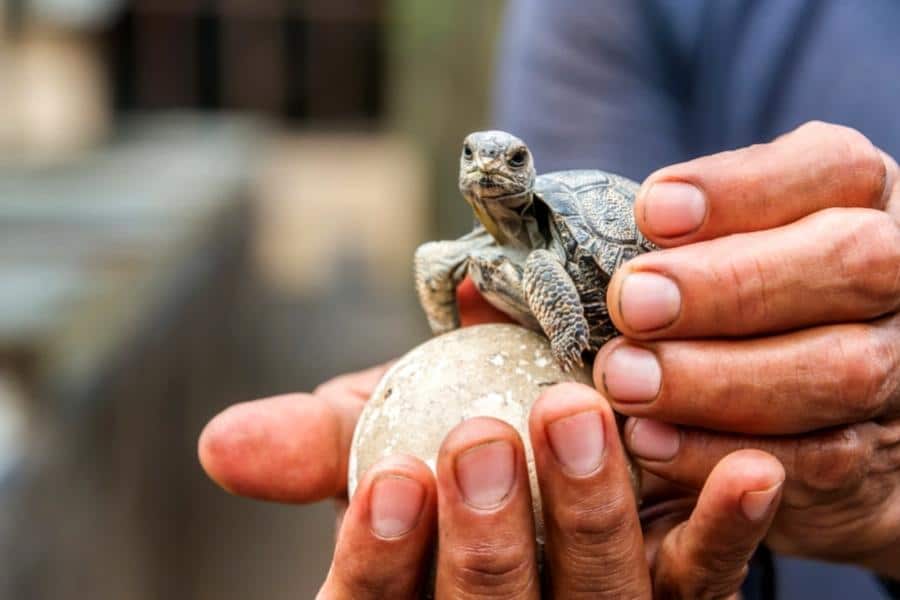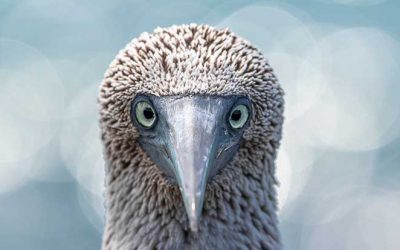Galapagos Giant Tortoises, how to know their sex?
Galapagos Giant Tortoises, how to know their sex?
Stay up to date with our most recent news and updates
Galapagos Giant tortoises are one of the most iconic species of the Galapagos archipelago. Their size alone makes them an interesting object of study for scientists and biologists, as well as one of the most popular sightings among travelers visiting the islands.
Their longevity also makes them unique, as some individuals have been known to live more than 100 years, making them the longest-living land animals on the planet. However, enjoying greater longevity also prolongs some processes that last much longer than in other species, such as reproduction; Galapagos giant tortoises reach sexual maturity at around 20-25 years of age.
Unlike many other animals, giant tortoises don’t have visible reproductive organs. For this reason, a frequent question that travelers ask when visiting the Galapagos Islands is, how do you know if a giant tortoise is male or female?
Keep reading this blog and learn the main keys to recognize the sex of these imposing tortoises that live in the highlands of Santa Cruz, Isabela, San Cristobal and Floreana islands in the Galapagos archipelago.
WHAT IS THE INCUBATION PROCESS OF GALAPAGOS GIANT TORTOISES, AND HOW DOES TEMPERATURE INFLUENCE IT?
To better understand how Galapagos giant tortoises are born, whether male or female, it is important to know how their formation process influences them, even before hatching, that is, during their incubation process.

The sex of the Galapagos giant tortoise depends on the temperature at which the egg is incubated, as this will determine whether the newly hatched tortoise is female or male.
During the incubation process, there are different characteristics that determine whether a giant tortoise will be born male or female, but the most significant is the temperature at which the eggs of this wonderful animal are incubated. It is known that the higher the temperature, around 29.5 °C degrees, the greater the chances that the newborn turtle will be a female. On the other hand, if the temperature is between 28 °C degrees or less, the probability that the newborn tortoise is a male, increases.
PHYSICAL TRAITS THAT DETERMINE THE SEX OF GALAPAGOS GIANT TORTOISES.
One of the most common ways to find out the sex of Galapagos giant tortoises is by visual analysis of their physical traits. This task may seem a bit complicated at first, but it is only a matter of knowing the characteristics well enough to easily find the answer. Below, you will find the 3 main physical traits, which allow you to better differentiate the sex of the Galapagos giant tortoises.
1. What does the shell of a male and female giant tortoise look like?
There is a difference between the shell size of male and female Galapagos giant tortoises; unlike what we might think, female giant tortoises have longer shells than males. However, this method is a bit misleading, as there may even be an overlap in size between a large male and a small female, so it is not possible to predict sex based on its shell size alone.
An additional point you should be aware of is the age of the Galapagos giant tortoise. If you assume that a giant tortoise is male because of the smaller shell size, you might actually be wrong because it could be a young, growing female. Irregularities can also occur when a male is huge and a female is small. Thus, both would match a certain size despite the difference between the sexes. Therefore, you might also look at other physical traits to complement your appreciation of the sex of giant tortoises. Please keep reading to learn more.
2. How do you recognize whether a Galapagos giant tortoise is male or female by its plastron?
As mentioned above, relying on a single characteristic may not be very useful, looking at a tortoise’s plastron can help you make a more accurate sex determination.
The belly of the giant tortoise or the underside of the shell is known as the plastron, and is also another main physical trait that can help us recognize whether a giant tortoise is male or female. If the plastron is concave, we can be sure that it is a male. On the other hand, when it is flat, it is characteristic of females.
This method is more accurate, since this differentiation also allows turtles to reproduce. The concave shape of the male’s plastron prevents him from sliding off when he is on top of the female during mating. Likewise, the flat shape of the females includes an inner space in which they lay their eggs.
3. The tail notch of the Galapagos giant tortoise, an important identifier.
There are several characteristics that help us identify the sex of these amazing animals, some are a little more complex than others, like this one that help us make sure if the others have left us with any doubts.
Male tortoises have a “V” shaped notch located on the underside of their tail where their shell and plastron end. This dimorphism allows him to accommodate his tail and penis for a more convenient position during the mating ritual.
Female tortoises have a notch on their tail, which looks like a “U”. This characteristic helps us recognize if it is a female Galapagos giant tortoise, and even more so if it matches the shape of its flat plastron. It’s getting easier and easier to know how to recognize a male or female tortoise, isn’t it?
Now that you know these methods for recognizing the sex of giant tortoises, you should also know when to see them and where to find them during your next vacation in the Galapagos Islands.
When is the best time to see giant tortoises in the Galapagos Islands?
The best time to see Galapagos giant tortoises in abundance is between June and December, as they take advantage of the cool temperatures of these months to feed and refresh themselves in the highlands of the islands where they live; Santa Cruz, Floreana, San Cristobal and Isabela.
This does not mean that the rest of the year they hide, or it is very difficult to observe them, in fact, the rest of the year they can also be seen, but in small scattered groups. In conclusion, if the reason for your trip is to observe these impressive reptiles, unique in the world, you can do so throughout the year.
Where to see giant tortoises in the Galapagos Islands:
The most popular places to see giant tortoises in the Galapagos Islands in the wild are undoubtedly the tourist ranches in the highlands of Santa Cruz Island, but they can also be seen on Floreana, San Cristobal and Isabela Islands.
While it is true that a trip to the Galapagos Islands is to observe its unique species in the world completely in their natural state, it is important to understand that several conservation programs are carried out for these beautiful specimens, which is why there are specialized breeding centers:
- Fausto Llerena Breeding Center (Santa Cruz Island).
- Charles Darwin Research Station (Santa Cruz Island).
- Arnaldo Tupiza Breeding Center (Isabela Island).
- David Rodríguez Breeding Center (San Cristóbal Island).
There are also some non-governmental organizations, such as the Charles Darwin Foundation, that carry out programs that promote the care of some species such as the Galapagos giant tortoises that are threatened and thus prevent their extinction.
Before concluding this brief article on how to recognize if a Galapagos giant tortoise is male or female, we would like to invite you to get to know them in detail and see where they live.
Surprise your friends and family with these interesting facts that very few people know!
If you want to apply your new knowledge, we invite you to take a look at our best Galapagos cruise deals, see which one suits your needs and start planning your next adventure here.
Here are some of our previous articles that may interest you before you visit the amazing Galapagos Islands:
LIVE THE EXPERIENCE!
📌 Discover our best deals, to the Galapagos Islands! Click here.
If you liked this post, share it with your friends and subscribe to our newsletter to keep up to date with interesting news from the Galapagos Islands 🐢 and Ecuador 🇪🇨.
RELATED POST
Traveling to the Galapagos Islands in 2022: tips, what to do, and how to book the best trip ever
Learn more about the Galapagos Islands and how to make the most of your trip to this natural destination with this quick guide.
Blue-footed Booby Interesting Facts
The blue-footed boobies of the Galapagos Islands, as beautiful as they are unique. Discover here some interesting facts about them.



